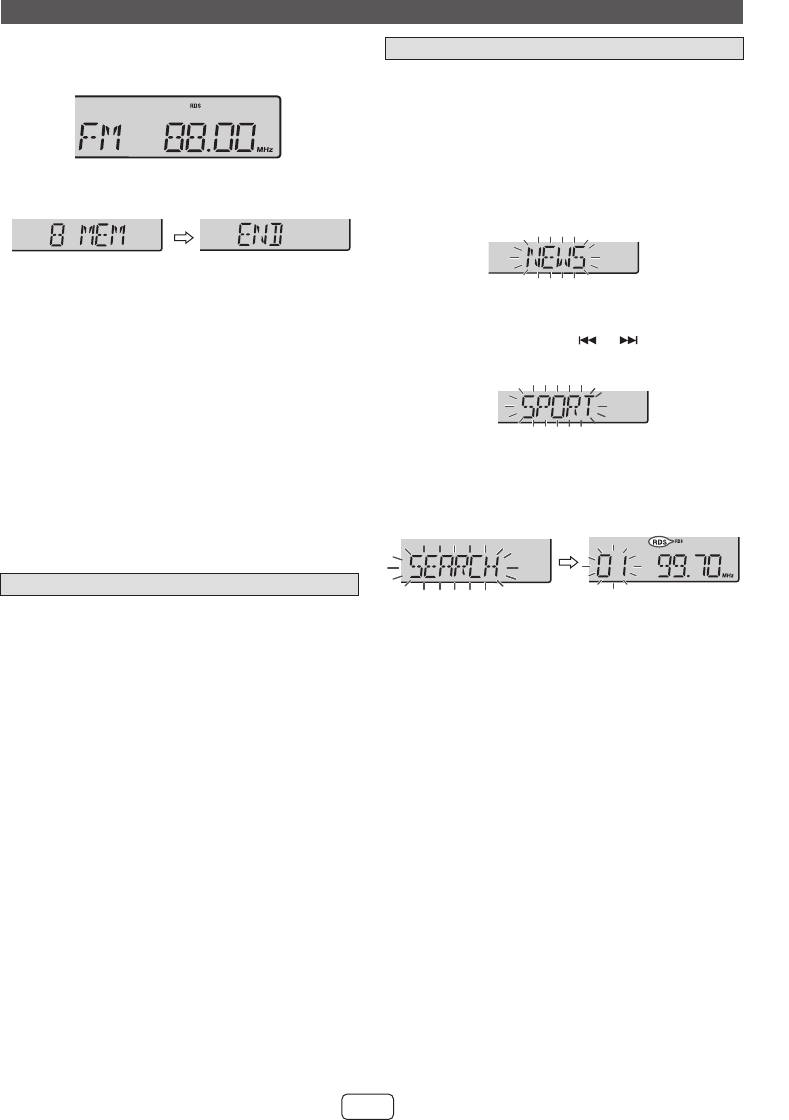
E-10
To stop the ASPM operation before it is complete:
Press the RDS (ASPM) button whilst it is scanning for
stations. The stations which are already stored in memory
will be kept there.
Notes:
● Any station which has the same frequency as the one
stored in memory will not be stored.
● If 40 stations have already been stored in memory, the
scan will be aborted. If you want to redo the ASPM
operation, erase the preset memory.
● If no station have been stored in memory, “00 MEM”
and “END” will appear for about 4 seconds.
● If the RDS signals are very weak, station names may
not be stored in memory.
● The same station name can be stored in different
channels.
● In a certain area or during certain time periods, the
station names may temporarily be different.
If any of the following events occur, it does not mean
that the unit is faulty:
● “PS”, “NO PS” and a station name appear alternately,
and the unit does not operate properly.
● If a particular station is not broadcasting properly or a
station is conducting tests, the RDS reception function
may not work properly.
● When you receive an RDS station whose signal is too
weak, information like the station name may not be
displayed.
● “NO PS”, “NO PTY” or “NO RT” will be displayed for
about few seconds, and then the frequency will be
displayed.
Notes for radio text:
● The first 8 characters of the radio text will appear for 4
seconds and then they will scroll across the display.
● If you tune in to an RDS station which is not
broadcasting any radio text, “NO RT” will be displayed
when you switch to the radio text position.
● Whilst radio text data is received or when the text
contents change, “RT” will be displayed.
To specify programmed types and select stations
(PTY search):
You can search a station by specifying the programme type
(news, sports, traffic programme, etc.) from the stations in
memory.
Notes:
● If the display has stopped flashing, start again from
step 2. If the unit finds a desired programme type, the
corresponding channel number will lit for about 4
seconds, and then the station name will remain lit.
● If you want to listen to the same programme type of
another station, press the RDS PTY button and start
again from step 2. The unit will look for the next station.
Using the Radio Data System (RDS) (continued)
2 When an RDS station is found, “RDS” will appear
for a short time and the station will be stored in
memory.
3 After scanning, the number of stations stored in
memory will be displayed for 4 seconds, and then
“END” will appear for 4 seconds.
■ Notes for RDS operation
■ To recall stations in memory
1
Press the FUNCTION button repeatly to select TUNER
function.
2 Press the RDS PTY button on the remote control.
Selected PTY code (blinking) will appear for about 6
seconds.
3 Within 6 seconds, press the or button to select
the PTY code.
Each time the button is pressed, the PTY code will
appear.
4 Whilst the selected PTY code is displayed (within 6
seconds), press the RDS PTY button again.
● The unit searches the all preset stations and stops
when it finds a station of the selected category then
tunes into the stations. The RDS indicator lights up.
● If no programme is found in the all preset stations,
“NO PTY” appear on the display and returns to the
previous station.


















